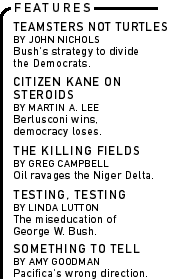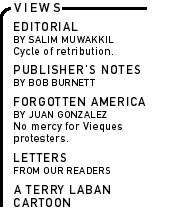

|

|

|

|
|
|
| |
|
|
|
In this era of eternal electioneering, the purpose of a presidential administration's first term can be summed up succinctly: to secure a second term. George W. Bush and Dick Cheney fully understand this principle. The current executive team is, after all, the first in 112 years to occupy the White House after losing the popular vote. In 2004, Bush and Cheney are determined to actually win the election. To that end, Bush's political team is paying inordinate attention to a set of numbers with which most Americans, even most progressives, are unfamiliar. While organized labor has struggled to increase the percentage of American workers who carry a union card in recent years, it has been highly successful in increasing the percentage of American voters who identify with the labor movement. Indeed, this could well be organized labor's most dramatic success story of the past decade. In 1992, according to Voter News Service, only 19 percent of voters identified themselves as members of union households. In 1996, that figure rose to 23 percent. In 2000, it was 26 percent. Since overall voter turnout was roughly the same between 1996 and 2000, that means that an additional 2.5 million union workers and members of their families cast ballots last year. A Peter Hart Research Associates poll found that the Democrats prevailed over Bush nationally by a 63 to 32 percent margin among such voters. Critically, union votes closed the deal for Al Gore in vital battleground states such as Wisconsin, Pennsylvania and Michigan--with a staggering 42 percent of the electorate wearing the union label in the latter. Were it not for the intervention of the Supreme Court, union votes certainly would have been credited with helping to deliver Florida--and the presidency--to Gore. All other things being equal, if organized labor simply continues to up the percentage of "union-household" votes at the same rate as it did during the '90s--and if those votes continue to trend Democratic at roughly the same clip--Bush will be finished in 2004. "It's clear that [in the 2000 election] union members exercised the unmatched power we hold as a united political force in this nation," says AFL-CIO President John Sweeney. "We're building a solidarity and culture of mobilization that will last, and we're going to build it even more." The Bush political operation--easily the most sophisticated ever constructed within the White House--may not be able to prevent the mobilization. But it is determined to undermine its solidity. Working with models from the re-election campaigns of Richard Nixon and Ronald Reagan, Bush political strategist Karl Rove is seeking to drive a wedge between blue-collar trade union members and environmentalists. The Bush political team is using a predictable lure: the promise of new jobs. At a closed-door meeting on May 14 between Vice President Dick Cheney, Labor Secretary Elaine Chao and leaders of 23 unions--mostly from the AFL-CIO's Building and Construction Trades Department--Cheney offered plenty for labor to get excited about. The Bush energy plan, he claimed, would include schemes to build up to 1,900 new power plants and 18,000 miles of fuel pipelines over the next two decades. According to the calculations favored by the Bush team, each new power plant would create 1,000 construction jobs and 200 permanent jobs, while every 1,000 miles of pipeline is good for another 5,000 jobs. And that doesn't even count the boom Cheney promised if the administration's dream of resurrecting the nuclear power industry is realized. White House aides saw the meeting as more than an energy policy briefing, however. For them, it was a high-stakes political overture with significant portents for the 2004 race. Hence, the presence of Rove, who performed introductions and reminded the union crowd that Cheney held an International Brotherhood of Electrical Workers union card when he worked summers as a utility company lineman in Wyoming. Cheney's official duty was to explain the administration's energy policy to leaders of the Teamsters, Steelworkers, Plumbers, Carpenters, Laborers, Steam Fitters and Seafarers unions. Unofficially, he was implementing a meticulous strategy aimed at dividing the Democratic base. If Washington reporters tended to miss that aspect of the story, Phil Clapp, the savvy president of the National Environmental Trust, did not. "The administration is trying to split the Democrats by wooing labor," Clapp said after the meeting. "It's quite an obvious strategy." And quite a successful one, if comments from some labor leaders who attended the meeting are any measure. "We like a lot of things," said Teamsters President James Hoffa. "We believe we need more nuclear plants. We believe we need more refining capacity; we haven't been building refineries." (Already, the Teamsters and Laborers have broken ranks to endorse Bush's proposal to open the Arctic National Wildlife Refuge for oil exploration.) There was appropriate skepticism about the administration's proposals. Union leaders sought but did not receive a commitment that jobs created under the Bush plan would go to unionized workers, or that essential materials--such as steel--would be produced in U.S. plants. Hoffa expressed concern about the Bush administration's ties to oil corporations--and about the prospect that the president's energy plan might ultimately do more to enrich big oil than workers and consumers. When all was said and done, however, Hoffa released a statement saying the Bush plan could create 25,000 Teamsters jobs in Alaska, and thousands more in other parts of the country. "The creation of jobs for Teamsters members can make strange bedfellows," he said, "but it's a bed we will lie in to keep our members working." Cheney and Rove were particularly pleased with the praise their plan received from Douglas McCarron, president of the 500,000-member United Brotherhood of Carpenters and Joiners. The Carpenters recently quit the AFL-CIO, with union Secretary-Treasurer Andris Silins saying at the time, "The AFL-CIO has strayed to social and environmental issues that have nothing to do with getting better wages and working conditions for working people." That may just sound like internal union bickering. But to the Bush team, that is the sweet sound of a crack opening in a traditional Democratic coalition. They know the sound well. They've heard it before. In the early '70s, Nixon borrowed a page from George Wallace and used racially charged talk about crime and school busing to pull southern Democrats and urban white ethnics from the north into his "silent majority." Reagan used culture-war appeals on issues such as abortion and gay rights to turn white, working-class Catholics from Cleveland and Pittsburgh into "Reagan Democrats." First elected in tightly contested races, Nixon and Reagan surged to second terms on the strength of millions of votes from traditionally Democratic union households. In 1984, when the AFL-CIO strongly supported Democrat Walter Mondale, exit polls showed that Reagan won 46 percent of the union household vote to Mondale's 53 percent. A major outreach to the leadership of key blue-collar unions and, by extension, to their millions of members is critical to replicating the Nixon and Reagan strategies. Besides efforts to find common ground with building trades and maritime unions on issues of job creation, the White House is actively seeking the support of the Machinists union for its National Nuclear Defense scheme--a.k.a. "Star Wars"--and the union has praised key aspects of the initiative. The strategy of pitting the Bush administration's job promises against Democratic concerns for the environment and nuclear disarmament is a smart one for the president. "It's worked before," says Wisconsin Secretary of State Douglas LaFollette, a Democrat with a long history of environmental activism. "When I was in the state Senate back in the '70s, I had a 100 percent AFL-CIO voting record. But I had a lot of run-ins with my friends in the labor movement because they were continually told by the Republicans that there was no way to reconcile jobs and the environment. I had really hoped we had gotten beyond the old divide-and-conquer approach. But it's no surprise to me that Bush--who is so anti-environment--would stir it up again." The Bush initiative is clearly a threat to the long-term prospects of the "Teamsters and Turtles" coalition of trade unionists and environmentalists forged in the 1999 Seattle protests against the World Trade Organization. The coalition played a big role in lobbying against permanent most-favored-nation trading status for China and is poised to be a prime player in the fight against Bush's efforts to win the "fast track" negotiating authority he would use to build a Free Trade Area of the Americas. (Indeed, few union leaders have lambasted Bush more loudly on the FTAA than Hoffa.) To a greater extent than ever before, the AFL-CIO leadership has built working relationships with organizations the labor movement once kept at arm's length--especially environmental groups such as the Sierra Club and Friends of the Earth. With early assaults on ergonomic rules, arsenic restrictions and dozens of other priorities of both the labor and environmental movements, the Bush administration has done more than enough to keep leaders of the two movements working together. But Rove and his crew don't expect union leaders to start appearing on Republican podiums anytime soon. Their goals are far more modest: If they can foster dissent between labor and environmental groups on job-creation issues, and if they can create an impression that the Democrats are more concerned about the environment than jobs, they will have positioned their man well to repeat the Nixon-Reagan scenario in states that are essential to Democratic chances in 2004. If the Rove strategy succeeds in simply shaving a few percentage points off the current level of union household support for any Democrat who challenges Bush, he will have earned his keep. And his political operation has already proven its ability to use the jobs issue as a hammer against Democrats: Consider the 2000 results from West Virginia where, despite united union support for Gore in a traditionally Democratic state, Bush prevailed with an environment-versus-jobs scare campaign. Forget about Florida--if Gore had simply won West Virginia, a state that voted for Mike Dukakis and Bill Clinton (twice), he would have been sworn in as president on January 20. Don't doubt Rove's determination to export the West Virginia strategy in 2004. So what are Democrats doing to challenge a Republican White House that is using some of the oldest tricks in the political playbook? Not enough. "The differences between our principles and President Bush's could not be greater," said House Minority Leader Richard Gephardt, as he unveiled a Democratic plan that argued in its introduction, "We believe that America's current and future energy needs can be met without compromising our nation's fundamental environmental values. We believe that the federal government can lead by example and become more energy efficient, invest in innovative technologies, and assure that energy markets are fair and competitive." That's a sound, if not particularly sexy, line of analysis. But where is the traditional Democratic promise of significant job creation? Where is the dramatic counter to Bush's pipe-dream of pipelines and old-fashioned power plants? Where is the promise of the massive alternative energy jobs program? Where is the public works promise that historically has cemented the relationship between Democrats and labor? The simple answer is that the "new realism" of the New Democrats says that public works programs of the traditional sort are no longer politically viable. What the New Democrats cannot explain, however, is why Democrats have had such a hard time winning congressional majorities since they began embracing the DLC's tepid, Republican-lite agendas for solving major problems. The Democratic alternative to the Bush administration's energy proposals must be every bit as aggressive and adventurous as the president's plan. The difference should not be in scope or scale--simply direction. Environmental groups make a sound case that more jobs can be created by developing clean, safe and affordable power and by promoting energy efficiency. "If the Building Trades, Machinists and Steelworkers look at the difference in the number of long-term jobs from building a few nuclear power plants and from retrofitting thousands of homes with solar panels, they will see there are a lot more long-term jobs in retrofitting," argues League of Conservation Voters President Deb Callahan. That message needs to be delivered quickly and loudly not just by environmental groups and service-sector unions with a penchant for green policies--such as the powerful Service Employees and American Federation of State, County and Municipal Employees--but also by the Democratic leadership in the House and Senate. And Democrats have to start talking about where they will find at least some of the money--or the regulatory force--to get such programs off the ground. That means taking far more seriously the rhetoric of the 2000 campaign about opposing gimmicky tax cuts for the rich. It also means that Democratic leaders will need to start listening to members who have spent time figuring out how energy programs can be good for labor and the environment. They could start with Ohio Rep. Dennis Kucinich, who earned national fame in the '70s when, as the mayor of Cleveland, he fought to defend that city's municipal power system. Now the chairman of the Congressional Progressive Caucus, Kucinich has developed visionary proposals for meeting the nation's energy needs while respecting the environment and creating jobs. One such plan, the Gas Price Spike Act, features ambitious proposals for providing tax credits to consumers who purchase highly efficient union-made cars, SUVs and light trucks. It also seeks to promote mass transit by providing funding for the reduction of fares. Where would Congress find the money to pay for these ambitious initiatives? Kucinich would start with a windfall profit tax on industries that manage gasoline, diesel, crude oil and home heating oil. As another Progressive Caucus stalwart, Vermont independent Rep. Bernie Sanders, points out, "If you go out and listen to people, you'll hear plenty of anger at the energy companies. There is a great deal of support out there for windfall profits taxes." Most Americans also oppose the Bush camp's approach. The latest Gallup poll shows 56 percent oppose opening Alaska's wildlife refuges for oil drilling, while just 40 percent back Bush's position. On the broader question of how to respond to current energy shortages, 52 percent favor conservation while 36 percent lean toward the Bush plan to increase production. The strategy for countering Bush, Cheney and Rove must speak the
language of both blue-collar workers and environmentalists. To do
so, however, progressives on both ends of the Teamsters-and-Turtles
coalition must force Democrats to challenge not merely Bush's cynical
environmental vision but Karl Rove's even more cynical political
schemes. "The Bush people know that Republicans have a lot better
chance of winning when they can drive that wedge in between labor
and the environmental movement," LaFollette says. "They know that
if they can sell the idea that Bush is for jobs and the Democrats
are not, he'll have a better chance to cut into the union vote that
went so strongly against him. That's their priority. The point is
to counter Bush and his people with a message that jobs and environmental
protection go together. And we can't be cautious in what we propose.
You know Bush's people won't be."
|

